ISSN ONLINE(2319-8753)PRINT(2347-6710)
ISSN ONLINE(2319-8753)PRINT(2347-6710)
Dr.John Cassius Moreki1, Tshoganetso Owen Woods2 and Patrick G. Nthoiwa3
|
| Related article at Pubmed, Scholar Google |
Visit for more related articles at International Journal of Innovative Research in Science, Engineering and Technology
This study was carried out to determine the levels of five heavy metals:lead (Pb), cadmium (Cd), chromium (Cr), copper (Cu) and zinc (Zn) in roadside forages harvested along a major highway (A1) in Dibete. The selected site was based on the forage harvesting activities within the area. Forage samples were collected at distances of 0, 15, 30, and 1000 m from the road. Atomic Absorption Spectrophotometer was used to analyse heavy metal concentration levels. Data were subjected to ANOVA at probability of 5% using the General Linear Models (GLM) procedure of SAS. Heavy metal concentrations were recorded in mg/kgwith Pb being highest at 3.6897±0.431 followed by Cr at 0.2085±0.084, Cd; 0.1297±0.056, Cu; 0.0867±0.060 and Zn the least at 0.0520±0.019. There were significant differences (P<0.05) in the concentrations of the five heavy metals at various distances. Heavy metal contents in forages at different distances from the road decreased with increasing distances from the road. The results showed that road side forages are contaminated with heavy metals. The high concentrations of heavy metals at 0 – 15 m from the roadside edge suggest that forages close to the roadside are a potential health hazard to both humans and livestock.Higher concentrations of heavy metals were recorded during the dry season relative to the wet season. The concentration of Cu was found to be independent of seasonal variation at P<0.05. These results suggest that forages harvested within road reserves should be used with extreme caution to feed livestock. It appears that forages harvested ≥30 m from the road have acceptable concentrations of heavy metals and could be used for livestock feeding.
Keywords |
| Dibete, forage, heavy metals, livestock, season |
INTRODUCTION |
| Vehicle emission causes remarkable metal contamination of the neighbouring roadside ecosystem. Lead (Pb) along with cadmium (Cd), copper (Cu), zinc (Zn) and chromium (Cr) are associated with the mobile sources [1,2]. These metals are included in petrol, tyres, lubricant oils and galvanized parts of the vehicles. The increase in the deposition of trace metals as pollutants from vehicle exhausts on plants raises concerns about the risks for the quality of food and in turn human health. Heavy metals emitted by vehicles can enter food chain through deposition on grasses growing by the road sides and grazed on by animals or harvested as fodder [3]. Metals such as Pb, Cd, Hg and Cu are cumulative poisons. Accumulation of heavy metals in tissues does not necessarily imply the occurrence of toxic effects because inactive complexes or storage may be formed by certain metals [4]. Heavy metals have been reported to be exceptionally toxic [3]. Lead has been associated with intoxications leading to problems in the kidneys and liver, the central nervous system, reproductive organs and anaemia in humans [5]. Several studies revealed higher than normal heavy metal concentrations on plants located near road sites compared with plants located in unexposed sites. Parkpian et al. (2005) [6] found that plants that grow nearer to the highways are usually exposed to more heavy metal accumulation than those away from highways. |
| In Botswana, cattle are raised in commercial and communal/traditional sectors. The traditional sector is practised on the tribal land [7]. Approximately 53% of the land in Botswana is used for grazing [8]. About 97% of cattle population is raised on communal land and is therefore reared under the traditional system [9]. Traditional systems are dominated by the cattle-post system, where a farmer or a group of farmers water livestock at a central watering point such as a well or a borehole, and the livestock wander freely over the grazing land around the watering point [10]. Livestock are normally grazed in the dry areas away from the rivers, but are watered from wells, either in dry, sandy river beds or from wells. Traditional cattle management is characterised by high stocking rates which commonly exceed recommended carrying capacity [9] resulting in overgrazing. On the other hand, the commercial enterprises are situated on freehold land. The commercial sector is a production system designed to maximise profits [7].Within the commercial sector, productions systems include intensive livestock production systems, such as feedlots. The greatest limitations to livestock production in Botswana are the quality and quantity of forage and grazing, as affected by the highly erratic rainfall. The irregularity of rainfall, both in time, and its highly scattered nature, means that fodder production is seasonal and local [11]. During the dry period when grazing is poor, forages growing along the Gaborone – Francistown highway (A1) are increasingly harvested as a source of animal feed (fodder). Such use might pose health risks not only to domesticated animals but also to humans via the food chain. Therefore, a study was conducted to estimate levels of heavy metals (Pb, Cd, Cr Cu and Zn) in forage harvested along A1 highway for livestock utilization as fodder around the Dibete area. |
ll. MATERIALS AND METHODS |
| A. Experimental site The research site is located along the Gaborone-Francistown (A1) highway approximately 20 km south of the Dibete cordon gate, about 110 km from Gaborone the capital city of Botswana (Fig. 1). The site is 25 km south of the Dibete village. The A1 highway is characterised by the heaviest cross country traffic to and from the north. Subsistence livestock production is the main activities within the study area. Often during the beginning of the dry season (i.e., March) there is commercial fodder harvesting taking place along the road side edges within the study area. This study was conducted on a site immediately adjourning the road. The GPS coordinates for the sampling area is between (S 23o 96´.580´´, E 26o 35´.085´´) and (S 23o 96´.099´´, E 26o 35´.338´´). There is an animal barrier (a fence) at a distance of about 30 m away from the highway which prevents livestock entering the road reserve. The experimental site was therefore chosen at distances of 0 m, 15 m and 30 m from the road edge and at 500 m apart along the edge of the road. The site was chosen based on the fact that forage harvesting activities are usually undertaken within the area during the dry period. In addition, herd boys (stock men) often graze livestock along the road reserve. The control site used was at a distance of about 1000 m from the road characterised by being remotely located from any form of industrial activity including vehicle exhaust fumes. The GPS coordinates for the control site are S 23o 95´.959´´, E 26o 35´.134´´. No residential dwellings were observed within the control site. |
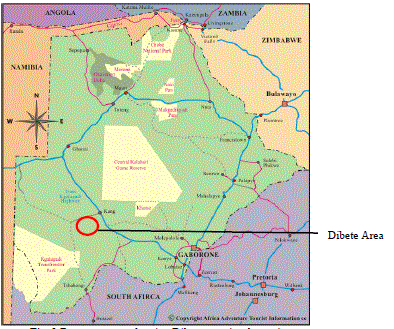 |
| Fig. 1 Botswana map showing Dibete area (study area) Source: Google Earth maps (2012) [12] |
| B. Collection of samples The forage samples were collected once during the dry season (i.e., August, 2012) and once during the rainyseason (i.e., February, 2013). Samples were taken at distance intervals of 0 m, 15 m and 30 m from the highway within the experimental site (Fig. 2). Three blocks were marked out at 500 m apart along the A1 highway. Each block had three sampling plots which were 15 m apart. The control site was 1000 m away from the road. A total of 10 sampling plots were marked out during each of the two sampling seasons and the sampling plots were identified by GPS coordinates. Three samples (replications) were taken for each of the distances within a sampling quadrat of 1 m2. Secateurs were used to clip the forage at mowing height to obtain the samples. Samples were individually packed into paper bags, labelled and taken to the laboratory for analysis. A total of 60 samples were collected during dry (30) and wet (30) seasons. |
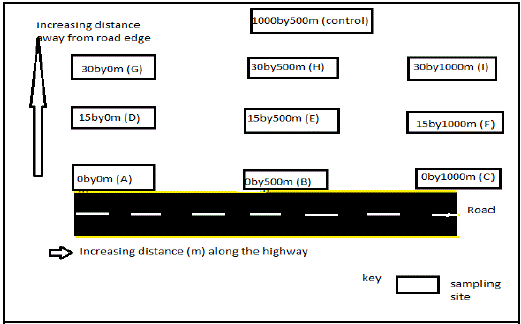 |
| Fig. 2 Graphic representation of the sampling site (not drawn to scale) |
| C. Sample preparations and preservation All forage samples were weighed to determinethe fresh weight before being washed in fresh running water to eliminate dust, possible parasites or their eggs. Samples were then washed with deionized water in the laboratory to prevent side reactions and contamination from the running tap water. The clean forage samples were air-dried and placed in an electric oven at 65 °C for 72 hours to reduce the moisture content to increase the storage time before digestion. The dry and fresh samples were air dried for 10 and 20 minutes respectively to evaporate the water obtained from washing with deionized water [13]. The dry samples were crushed using mortar and pestle, as well as, electric grinder and the resulting powder packaged in honey jars for later heavy metal analysis (Pb, Cr, Cu and Cd). D. Procedure for digestion of forage samples Approximately 0.5 g of the ground sample powder wastransferred to a 125 ml conical flask, 5 ml ofconcentration (98%) sulphuric acid (H2SO4) was added followed by 25ml of concentrated (55%) Nitric Acid (HNO3) and 5 ml of concentrated(72%) Hydrochloric Acid (HCl). The contents of the conical flask were heated at200 °C for 1 hour in a fuming hood. The digested material was allowed to cool to room temperature overnight. Thereafter, 20 ml ofdeionized water was added and the mixture wasfiltered using Macherey-Nagel filter paper No.1 (11 cm) to completethe digestion of organic matter. The mixture was transferred to a 50 ml volumetric flask, filled to the mark with deionized water, and let to settle for at least 15 hours. The resultant supernatant was analysed for concentration levels of Cd, Cu, Cr, Zn and Pb by Atomic Absorption Spectrophotometer, Varian Spectra 220FS model. E. Data analysis A Randomized Complete Block Design (RCBD) statistical design was used to set up the experimental units (sites). Data were subjected to ANOVA using the General Linear Models (GLM) procedure of Statistical Analysis Software (SAS) [14]. Treatment means were separated and grouped using Duncan’s Multiple Range Test for values and Least Significant Difference (LSD) at 5% level of confidence. |
III. RESULTS AND DISCUSSION |
| A. Level of heavy metals in forages Data on heavy metal concentration in forages obtained from different locations along the A1 highway at Dibete are presented in Table 1. Forage concentrations of Pb, Cr and Cd were significantly (P<0.05) different from each other. However, Cu and Zn did not differ from each other but differed (P<0.05) from Pb, Cr and Cd. Lead concentration was significantly higher (P<0.05) than other heavy metals studied. The Pb concentration was 3.6897±0.431 mg/kg. Heavy metal concentrations in forages at different distances from the road were found in the following order: Pb>Cr>Cd>Cu>Zn. The concentrations of Cu and Zn were not significantly (P>0.05) different. Similarly, Naseret al. (2012) [13] in a study in Bangladesh noted that heavy metals contents both in the soils and vegetables for every distance from the road occurred in the order Ni>Pb>Cd and there were significant differences in the concentrations of Pb, Cd, and Ni for different plant species at various distances. |
 |
| Table 1.Mean heavy metal concentration in mg/kg (±, standard deviation) of forage |
| Means within the same column with a common letter do not differ significantly (P <0.05) Each value is a mean of replicates (n=60) B. Effect of season on heavy metal concentration in forages Data on the effect of season on heavy metal concentration in forages are given in Table 2. According to Table 2, all heavy metals except Cu were affected (P<0.05) by season. The concentrations of heavy metals on forages harvested along the A1 road during the dry and wet seasons ranged between 3.759±0.419 and 0.061±0.023 mg/kg and 3.598±0.084 and 0.043±0.011 mg/kg, respectively. A relatively low concentration of heavy metals was noticed during the wet season than during the dry season (Table 2). The mean concentration of Pb, Cr, Cd and Zn during the wet and dry seasons significantly (P <0.05) differed. However, the mean concentration of Cu during the wet and dry seasons did not differ significantly (P <0.05). During the wet and dry seasons the concentration of heavy metals in forages at different distances from the road were found in the following order: Pb>Cr>Cd>Cu>Zn. According to Solomon (2000) [15], during the wet season prevailing winds combined with prevailing rainfall makes it impossible for the forage to actively absorb heavy metals either through the stomatal pore deposits or the roots of forage. The differences in concentration of heavy metals between the dry and wet seasons can also be attributed to a number of factors including the climatic conditions and geological features such as trace mineral content in soils within the study area. Table 2.Mean Pb, Cr, Cd, Cu and Zn concentration in mg/kg (±, standard deviation) of forage by seasonal variations per heavy metal |
 |
| Means within the same column with a common letter do not differ significantly (P <0.05) Each value is a mean of replicates (n=30). In the study by Solomon (2000) [15] it was noted that during the dry season, steady breezes expedite an easy drift of trace minerals from both tyre wear and exhaust fumes into the forages and soils around the major roads in Botswana resulting in higher levels of heavy metals in forages. The higher concentration of heavy metals during the dry season coincides with the relative shortage of grazing pasture outside the road reserve. The reduction in grazing pastures is mostly due to overgrazing of the communal grazing lands. It is during these periods that both livestock and their owners are attracted to either harvesting the forage or grazing their livestock within the road reserve. Grazing of livestock within the road reserve leads to excessive accumulation of toxicity which ultimately concentrates down the food chain. McDowel (1985) [16] observed that livestock is prone to heavy metal toxicity during the dry season which is aggravated by their emaciated body condition. C. Effect of distance on heavy metal concentrations in forages Table 3 shows the mean heavy metal concentrations at each sampling site. The results show a significant (P<0.05) decline in concentration levels for Cr, Cd, Cu and Zn as the distance from the road edge increases. Table 3.Mean Pb, Cr, Cd, Cu and Zn concentration in mg/kg (±, standard deviation) of forage by distance away from road |
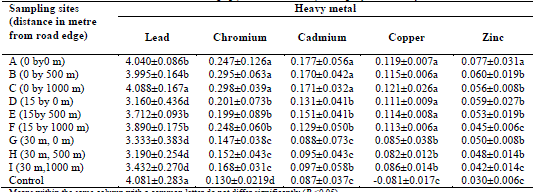 |
| In the present study, Pb concentration was significantly (P>0.05) higher at site C and control site compared to other sampling sites. The higher Pb concentration in this study could be a result of an underlying contamination source which was not physically evident at the control site. No reason could be given for higher Pb concentration at the control site. Lead forage concentrations harvested at sites A, B, E and F, were significantly (P<0.05) higher than at sites D, G, H and I. Generally, Pb concentration in forages was lower at a distance of 30 m from the road edge. The Pb content in forages ranged from 3.160±0.436 mg/kg to 4.081±0.283 mg/kg. The present study showed significant (P>0.05) decline in Pb concentration as the distance from the road edge increased. Figure 2 shows the trend in Pb concentrations at different sampling sites for both the wet and dry seasons. Seasonal variations contributed significantly (P<0.05) to the differences in Pb concentrations with Pb concentration being higher in forages harvested during the dry season. Rain wash off could be the leading factor in decreased concentration during the wet season. The increased heavy metal concentrations and the seasonal concentration level in forages harvested along the A1 highway suggest that passing motor vehicles on the roads were the sources of Pb to the roadside forages. The current results are in agreement with Word et al. (1977) [17] and Sitholeet al. (1993) [18] who observed that the concentration of heavy metals in plants increased nearer to the roadside and decreased with increasing distance from roadside. Rodriguez et al. (1982) [19] reported that accumulation of Pb and Cd above tolerable levels takes place up to a distance of approximately 33 m. The current results suggest that forage production or forage harvesting for livestock feeding should be done ≥30 m from the road edge. Similarly, Motto et al. (1970) [20] found that most of the effects of Pb discharge from automobiles is confined within a zone 33 m wide, measured from the road edge. Normally, plant Pb levels vary from 1 to 12 mg /kg dry weight [21]. The Pb concentrations observed in forages of the different sampling distances in the present study were below the toxic level of 25 mg/kg reported by World Health Organization (1995) [22]. |
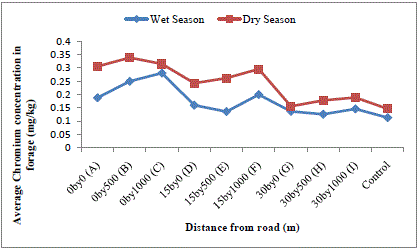 |
| Fig. 2 Average Pb content in forage cut along A1 road around Dibete Area The Cr concentrations of forages harvested at site A, B and C were significantly (P<0.05) higher than concentration of forages harvested at distances D, E, F, G, H, I and control. The Cr concentration of forages harvested at sites D, E and F were not significantly (P>0.05) different from each other but differed significantly (P<0.005) from sites G, H and I. Forage harvested at the control site had the lowest Cr concentration and significantly (P<0.05) differed from the concentration of forage harvested at other sites (Table 3). The Cr content in forages was 0.130±0.0219 mg/kg at the control site and 0.247±0.126 mg/kgat site A from the road (Table 3). Forage concentrations of Cr from roadsides appeared to be in the spatial pattern of distribution and in the order of 0 m>15 m>30 m>1000 m (control site). Figure 3 shows a decreasing trend of Cr concentration away from the road edge. The increased Cr concentration closer to the road side could be a result of the direct deposition of the metal particulates and exhaust fumes from vehicles on the roadside forages. This deposition pattern is similar to earlier results reported by Abdourahamaet al. (2008) [23]on road side grass. Khan (2008) [24] stated that at an elevated concentration of Cr could be toxic to plants and animals. The concentrations of Cr at 5-30 mg/kg are considered critical for plants and could result in the decline of yield. Figure 3 presents the Cr concentration in forages during the dry and wet seasons. There was a significant (P<0.05) difference in Cr concentration in forages due to seasonal variation. The differences could be attributed to the follicular surface deposits which are easily washed off by rainfall or from the passing vehicle splashes during the wet season along the A1 road. |
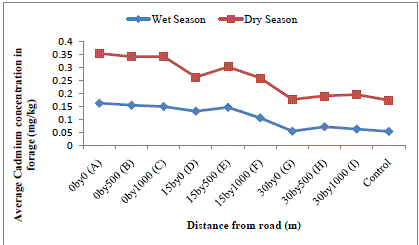 |
| The mean Cd concentrations at different distances from the road edge are illustrated in Fig. 4 and Table 3. Cadmium concentrations at sampling sites A, B, and C were significantly (P<0.05) higher compared to other sampling sites. Samples collected at sites G, H and control had a significantly (P<0.05) lower concentration than those from sites D, E, F and I. The Cd values in this study were below the toxic limits in plants at 5-30 mg/kg. Hewitt and Rashed (1988) [25] attributed the sources of Cd in the forages to metal plating and lubricating oils used in automobiles. Higher Cr concentrations could also be due to rough surfaces of the roads which increase tyre wears, and run-offs from the roadsides.Previous study by Jarupet.al.(1998) [26] reported that emissions from heavy traffic also lead to increased Cd concentration in plants along highways. Furthermore, Word et al. (1977) [17] in New Zealand reported that motor vehicle traffic is responsible for the build-up ofCd and nickel in soils and vegetation along motorways. Naseret al. (2012) [13] also noted that Cd levels in roadside plants decrease with increased distance from the main road. Forage Cd concentration in this study was significantly (P< 0.05) affected by seasonal variations. The dry season had a higher Cd concentration than the wet season (Table 2). The highest concentration of Cd was found in forage cut during the dry season at site A. Figure 4 shows the variation in concentration levels at different distances due to dry and wet seasons. The concentration of Cd in this study was lower than 2 mg/kg reported by Ho and Tai (1988) [27] in Hong Kong and Awofolu (2005) [28] along some selected major roads in metropolitan city of Lagos in Nigeria. |
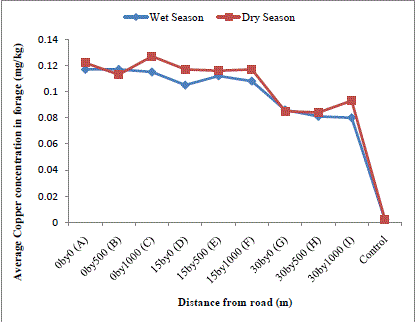 |
| Fig. 4 Average cadmium content in forage cut along A1 road around Dibete Area The Cu concentrations of forages obtained at sites A, B, C, D, E and F were not significantly (P>0.05) different from each other but were significantly (P<0.05) higher compared to other distances. Copper concentration in samples harvested at distance G, H and I were significantly (P<0.05) higher than forage obtained at the control site (Fig. 5). Copper concentration was relatively lower at the control site recording a value below zero. Solomon (2000) [15] in Botswana reported a higher Cu concentration of 36.500 ppm in forages harvested near road edges. The current results on Cu concentration are in disagreement with Solomon (2000) [15] who found that distance had no effect on Cu concentration. The difference in results could be ascribable to the differences in volume of traffic, speed of traffic and location of the two studies. |
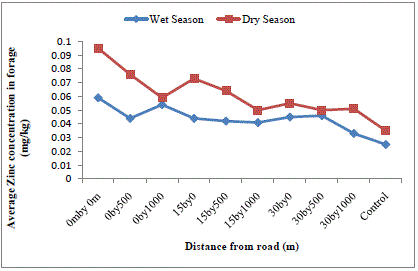 |
| Fig. 5Average copper content in forage cut along A1 road around Dibete Area Zinc concentration in forages obtained at site A was significantly (P<0.05) higher compared to other distances (Table 3). The concentration of Zn in forages harvested at sites B,C, D, E and H was not significantly different from each other but significantly (P>0.05) differed from sites A, F, I and control. However, Zn concentration in forages harvested at sites I and control did not differ significantly. Ray and George (2010) [29] stated that traffic is a good source of Zn deposition along the highways, especially vehicle tyres or other metallic parts of vehicles and road paints. According to Fatoki (1997) [30], Zn levels correlates with average daily traffic in the roads and the mean levels of Zn vary exponentially with increase in distance from the road. Zinc concentration in forages was influenced by seasonal variations (Table 3, Figure 6). The dry season had a higher Zn forage concentration than the wet season (Table 2). Rain wash off could be the major contributory factor to decreased Zn concentration during the wet season. Paschkeet al. (2000) [31] mentioned that Zn usually occurs in lower concentrations and does not pose a toxicity problem for plants. |
IV. CONCLUSIONS |
| The present results have shown that Pb concentration in forages harvested along road sites was overly higher than other trace minerals. Generally, the concentration of Cr, Cd, Cu and Zn declined as the distance from the road edge increased. All heavy metals in this study were significantly (P>0.05) affected by seasonal variation except Cu. The forage heavy metal concentrations in the current study were below toxic levels. It therefore appears that forage harvesting for livestock feeding around the Dibete area should be done not less than 30 m from the A1 road edge to minimise contamination. |
ACKNOWLEDGEMENTS |
| The authors express their profound gratitude for the assistance they received from M.O Mathaio for facilitating the use of the University Botswana laboratory. Also, E.O. Mokobi, L. Morekisi and O. Mogomotsi from the Department of Environmental Science of the University of Botswana are sincerely thanked for their assistance during the laboratory analysis. |
References |
|